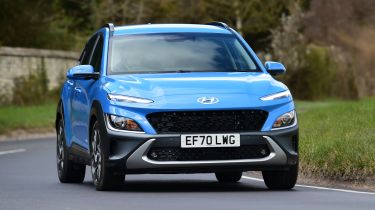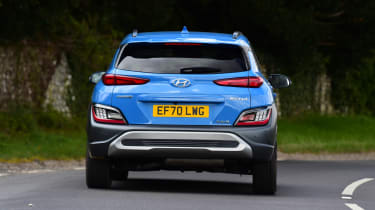Hyundai Kona (2018-2023) review - Engines, performance and drive
The Kona isn't an involving drive, although chassis and suspension tweaks bring some welcome improvements to ride and handling

We haven't really seen a small SUV that's genuinely involving to drive, and the Kona doesn't come close to bucking this trend. It has few vices, admittedly, but there is precious little scope for enjoyment either.
The 1.0-litre petrol engine in the base Kona has just about enough grunt for most everyday situations, although you'll need to keep an eye on the rev-counter if you're about to attempt overtaking. That's because the three-cylinder turbocharged engine has a pretty narrow power band; Hyundai claims peak torque between 1,500rpm and 4,000rpm, but it feels like it starts about 700rpm higher than that.
Drop out of the zone and you'll soon find yourself becoming impatient as you wait for the motor to spin up to its best potential again. Other three-cylinder units on the market are punchier – notably Citroen's and Peugeot's excellent 1.2 PureTech.
We didn't find the mild-hybrid Kona's six-speed manual gearbox was the slickest when we drove it, but it’s quick enough as long as you’re positive with shifts. The squared-off gear lever feels awkward in your hand, however.
The facelifted Kona has benefitted from tweaks to its chassis and suspension, which provide a little more dynamic polish over the previous model – particularly in its ability to now absorb the bumps and jolts from rutted urban roads, even when riding on bigger 18-inch alloy wheels.
Used - available now
Once it’s up to speed, the Kona is pretty quiet, as the characterful three-cylinder note fades away. Wind noise seems well isolated, too, so there’s not much of a rush from around the side mirrors.
If you’re willing to stretch a couple of grand beyond the cost of the 1.0-litre Kona, the Kona Hybrid makes for a compelling choice. It’s powered by a 1.6-litre petrol engine and a small electric motor, with the main benefit being fuel economy: on paper it’s significantly more frugal than any other petrol-powered Kona.
The Kona Electric goes around corners in much the same way as its combustion-engined counterparts, but it quieter, smoother, more powerful drivetrain makes it by far the most pleasant model variant to drive.
There's no shortage of straight-line speed from the 276bhp Kona N performance model, and it has enough electronic trickery to keep keen driver's entertained. The rest of the family won't feel quite so positive towards the racy Kona model, as it's firm set-up makes things a little uncomfortable when on the move – even motorway trips become tiring with plenty of road noise entering the cabin.
0-62mph acceleration and top speed
The Kona comes with a choice of engines – although in truth, we expect the vast majority of customers will end up in the more modest base model. It's powered by a turbocharged 1.0-litre three-cylinder motor, producing 118bhp and 172Nm of torque.
On the whole, this engine is punchy enough for a car like the Kona. But in practice, we find its powerband a little narrow - and it's quick to punish you with sluggish progress if you allow the revs to dip much below 2,000rpm. You certainly won't be able to hurry the Kona into much of a sprint, as Hyundai claims the 0-62mph time is a rather sedate 11.9 seconds
The full hybrid's mix of 1.6-litre four-cylinder engine and electric motor results in a total output of 139bhp and 265Nm of torque, although it's still not blisteringly quick – taking 8.9 seconds to reach 62mph from a standstill. However, this set-up allows you to cover short distances in fully electric mode, which is most noticeable at low speeds when the Kona will move off smoothly and silently.
Hyundai offers the Kona Electric with either a 39kWh battery and 134bhp electric motor, or a 64kWh unit paired with a 201bhp e-motor. Both are more capable sprinters, taking 9.9s and 7.9s to 62mph, respectively.
The 2.0-litre, four-cylinder unit in the Kona N produces 276bhp and a healthy 392Nm of torque, which means 0-62mph is taken care of in 5.5 seconds. Top speed is 149mph.














